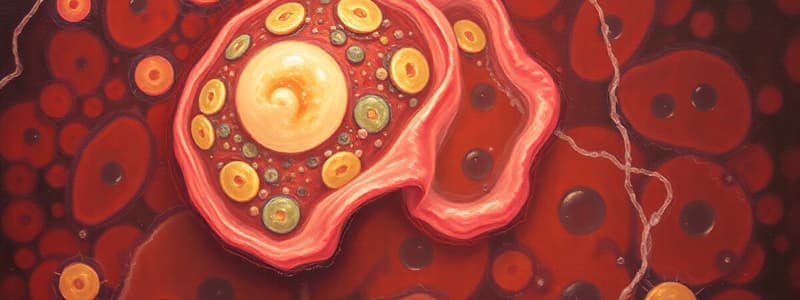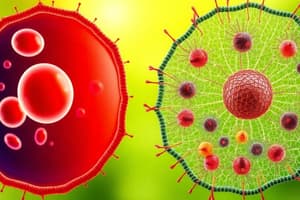Podcast
Questions and Answers
Which of the following best describes the core concept of cell theory?
Which of the following best describes the core concept of cell theory?
- Cells are only found in plants and animals.
- All living organisms are composed of cells, which are the basic units of life and arise from other cells. (correct)
- Cells are primarily composed of non-living material.
- Cells are static and never change.
Which scientist is best known for observing bacteria and calling them 'animalcules'?
Which scientist is best known for observing bacteria and calling them 'animalcules'?
- Robert Hooke
- Theodor Schwann
- Matthias Schleiden
- Anton van Leeuwenhoek (correct)
What is the primary distinction that differentiates prokaryotic cells from eukaryotic cells?
What is the primary distinction that differentiates prokaryotic cells from eukaryotic cells?
- Prokaryotic cells lack a nucleus and other membrane-bound organelles. (correct)
- Eukaryotic cells are smaller in size.
- Eukaryotic cells are less metabolically active.
- Prokaryotic cells contain a nucleus and other organelles.
Which of the following statements accurately describes the role of Rudolf Virchow in the development of cell theory?
Which of the following statements accurately describes the role of Rudolf Virchow in the development of cell theory?
What term did Robert Hooke use when describing what he saw under a microscope, which ultimately contributed to the notion of 'cells'?
What term did Robert Hooke use when describing what he saw under a microscope, which ultimately contributed to the notion of 'cells'?
Which two scientists are credited with establishing that both plants and animals are made of cells, respectively?
Which two scientists are credited with establishing that both plants and animals are made of cells, respectively?
Where is the DNA located in a prokaryotic cell?
Where is the DNA located in a prokaryotic cell?
What does the term 'eu' refer to in the word 'eukaryotic'?
What does the term 'eu' refer to in the word 'eukaryotic'?
Which of the following is NOT a characteristic of a prokaryotic cell?
Which of the following is NOT a characteristic of a prokaryotic cell?
In eukaryotic cells, what is the primary function of the ribosomes?
In eukaryotic cells, what is the primary function of the ribosomes?
Which organelle is directly involved in the modification and transportation of proteins and lipids?
Which organelle is directly involved in the modification and transportation of proteins and lipids?
What is a key difference in the structure of cell walls between plants and bacteria?
What is a key difference in the structure of cell walls between plants and bacteria?
Which cellular structure is responsible for maintaining the shape and providing support to the cell?
Which cellular structure is responsible for maintaining the shape and providing support to the cell?
What is the primary function of the cell membrane?
What is the primary function of the cell membrane?
Which of the following best describes the role of the smooth endoplasmic reticulum (ER)?
Which of the following best describes the role of the smooth endoplasmic reticulum (ER)?
In plant cells, what is the function of the large central vacuole?
In plant cells, what is the function of the large central vacuole?
Which organelle is responsible for the production of energy, often called the 'powerhouse' of the cell?
Which organelle is responsible for the production of energy, often called the 'powerhouse' of the cell?
Which of the following is NOT a component of a typical eukaryotic cell?
Which of the following is NOT a component of a typical eukaryotic cell?
Flashcards
Nucleus
Nucleus
The control center of a eukaryotic cell, containing DNA and directing cellular activities.
Mitochondria
Mitochondria
The powerhouse of the cell, where energy in the form of ATP is produced.
Chloroplasts
Chloroplasts
Found in plant cells, they use sunlight to produce food through photosynthesis.
Ribosomes
Ribosomes
Signup and view all the flashcards
Endoplasmic Reticulum (ER)
Endoplasmic Reticulum (ER)
Signup and view all the flashcards
Golgi Apparatus
Golgi Apparatus
Signup and view all the flashcards
Lysosomes
Lysosomes
Signup and view all the flashcards
Vacuoles
Vacuoles
Signup and view all the flashcards
Cytoskeleton
Cytoskeleton
Signup and view all the flashcards
Cell Wall
Cell Wall
Signup and view all the flashcards
Cell Theory
Cell Theory
Signup and view all the flashcards
Prokaryotic Cells
Prokaryotic Cells
Signup and view all the flashcards
Eukaryotic Cells
Eukaryotic Cells
Signup and view all the flashcards
Robert Hooke
Robert Hooke
Signup and view all the flashcards
Anton Van Leeuwenhoek
Anton Van Leeuwenhoek
Signup and view all the flashcards
Matthias Schleiden
Matthias Schleiden
Signup and view all the flashcards
Theodor Schwann
Theodor Schwann
Signup and view all the flashcards
Rudolf Virchow
Rudolf Virchow
Signup and view all the flashcards
Study Notes
Cell Theory
- Cell theory describes cells, the fundamental units of life
- Three tenets:
- All living things are made of one or more cells
- The cell is the basic unit of structure and function in living organisms
- All cells come from pre-existing cells
- Key figures in developing the theory:
- Robert Hooke: First observed and named cells
- Anton van Leeuwenhoek: Observed bacteria ("animalcules")
- Matthias Schleiden: Discovered plant cells
- Theodor Schwann: Discovered animal cells
- Rudolf Virchow: Proposed cells arise from other cells
Cell Types
- Two main categories:
- Prokaryotic cells: Simpler, no nucleus, DNA floats in cytoplasm, examples include bacteria
- Eukaryotic cells: More complex, have a nucleus containing DNA, examples include plants, animals, fungi, protists
Prokaryotic vs. Eukaryotic Cells
| Feature | Prokaryotic | Eukaryotic |
|---|---|---|
| Nucleus | No | Yes |
| Organelles | No membrane-bound organelles | Yes, membrane-bound organelles |
| Cell Division | Binary fission | Mitosis or meiosis |
| Cell type | Unicellular | Unicellular or multicellular |
| Cell walls | Yes (peptidoglycan) | Sometimes (e.g., plants, fungi) |
| Examples | Bacteria, Archaea | Plants, animals, fungi, protists |
Eukaryotic Organelles
- Nucleus: Control center, stores DNA
- Mitochondria: Powerhouse, produces ATP (energy)
- Chloroplasts (plant cells): Capture sunlight for photosynthesis
- Ribosomes: Protein factories
- Endoplasmic Reticulum (ER):
- Rough ER: Protein production
- Smooth ER: Lipid production and detoxification
- Golgi Apparatus: Packages and ships proteins/lipids
- Lysosomes (animal cells): Digest waste
- Vacuoles:
- Plant cells: Large central vacuole, stores water/nutrients, maintains shape
- Animal cells: Smaller vacuoles, also for storage
- Cytoskeleton: Maintains cell shape and support
- Cell Wall (plants, fungi, bacteria): Rigid outer layer, provides structure and protection (plant cell walls are cellulose)
- Cell Membrane: Controls what enters/exits the cell, composed of a phospholipid bilayer
Practice Questions
- Question 1: Which organelle produces ATP? Answer: Mitochondria
- Question 2: What's a major difference between plant and animal cells? Answer: Plant cells have a large central vacuole.
- Question 3: Briefly describe the difference between prokaryotic and eukaryotic cells. (Open-ended, answer expected)
Studying That Suits You
Use AI to generate personalized quizzes and flashcards to suit your learning preferences.




